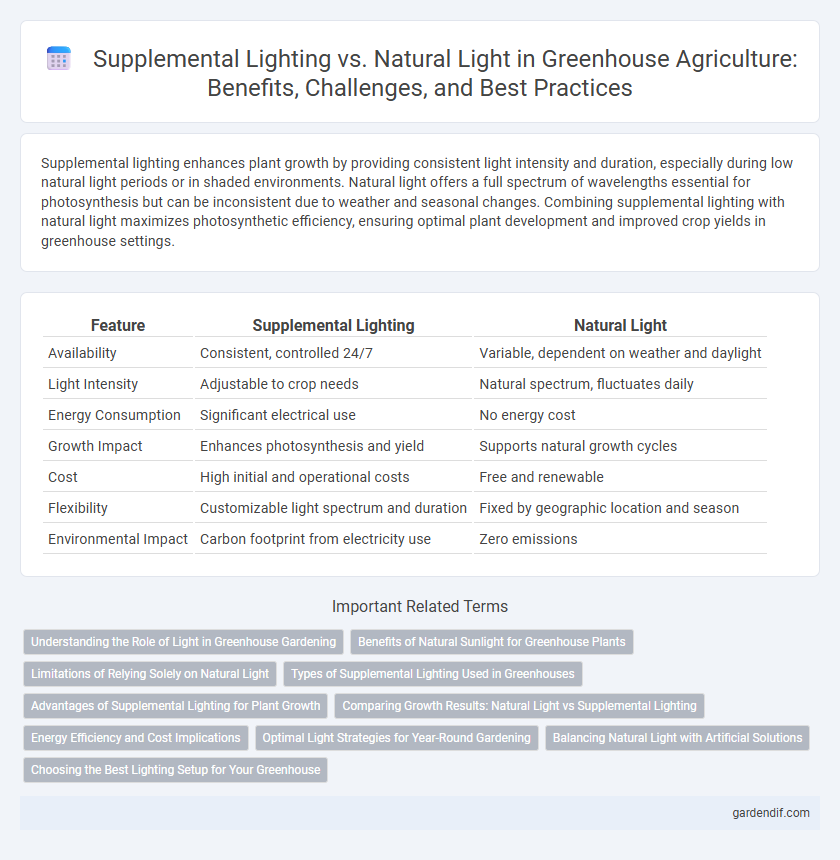
Supplemental Lighting vs Natural Light Illustration
Supplemental lighting enhances plant growth by providing consistent light intensity and duration, especially during low natural light periods or in shaded environments. Natural light offers a full spectrum of wavelengths essential for photosynthesis but can be inconsistent due to weather and seasonal changes. Combining supplemental lighting with natural light maximizes photosynthetic efficiency, ensuring optimal plant development and improved crop yields in greenhouse settings.
Table of Comparison
| Feature | Supplemental Lighting | Natural Light |
|---|---|---|
| Availability | Consistent, controlled 24/7 | Variable, dependent on weather and daylight |
| Light Intensity | Adjustable to crop needs | Natural spectrum, fluctuates daily |
| Energy Consumption | Significant electrical use | No energy cost |
| Growth Impact | Enhances photosynthesis and yield | Supports natural growth cycles |
| Cost | High initial and operational costs | Free and renewable |
| Flexibility | Customizable light spectrum and duration | Fixed by geographic location and season |
| Environmental Impact | Carbon footprint from electricity use | Zero emissions |
Understanding the Role of Light in Greenhouse Gardening
Supplemental lighting in greenhouse gardening enhances plant growth by providing consistent light intensity and spectrum, especially during low natural light periods or shorter days. Natural light offers a broad spectrum and intensity essential for photosynthesis but can be unpredictable due to weather or seasonal changes. Optimizing the balance between supplemental lighting and natural light maximizes photosynthetic efficiency, crop yield, and energy use in controlled environment agriculture.
Benefits of Natural Sunlight for Greenhouse Plants
Natural sunlight provides greenhouse plants with a full spectrum of light essential for photosynthesis and growth, promoting healthier and more vigorous development compared to supplemental lighting. Exposure to natural sunlight enhances nutrient uptake and improves the production of chlorophyll, resulting in higher yields and better-quality crops. Utilizing sunlight reduces energy costs and environmental impact, making it an efficient and sustainable choice for greenhouse cultivation.
Limitations of Relying Solely on Natural Light
Relying solely on natural light in a greenhouse limits plant growth due to inconsistent light intensity and duration, especially during cloudy days and shorter winter periods. Natural light variation can lead to uneven photosynthesis rates, affecting crop yield and quality. Supplemental lighting ensures a stable and optimized light spectrum that promotes uniform growth regardless of external weather conditions.
Types of Supplemental Lighting Used in Greenhouses
Supplemental lighting in greenhouses primarily includes high-pressure sodium (HPS) lamps, light-emitting diode (LED) grow lights, and fluorescent lamps, each designed to enhance plant growth by providing specific light spectra. HPS lamps are widely used for their intensity and efficiency in promoting flowering and fruiting, while LED grow lights offer customizable wavelengths and energy savings, making them ideal for various growth stages. Fluorescent lights serve well for seedlings and low-light plants due to their lower heat output and cost-effectiveness, ensuring year-round cultivation regardless of natural light availability.
Advantages of Supplemental Lighting for Plant Growth
Supplemental lighting in greenhouses extends the photoperiod, boosting photosynthesis and accelerating plant growth regardless of external weather conditions. It provides consistent light intensity and spectrum tailored to specific plant species, enhancing yield quality and uniformity. Controlled supplemental lighting also mitigates the limitations of natural light variability, ensuring optimal growth during low-light seasons or cloudy days.
Comparing Growth Results: Natural Light vs Supplemental Lighting
Natural light provides a full spectrum of wavelengths essential for photosynthesis, promoting balanced plant growth and stronger structural development. Supplemental lighting, particularly LED systems, allows precise control of light intensity and photoperiod, enhancing growth rates and yields in environments with limited natural light. Studies show greenhouses using supplemental lighting achieve up to 30% higher crop productivity compared to natural light alone, especially during low sunlight periods.
Energy Efficiency and Cost Implications
Supplemental lighting in greenhouses optimizes plant growth during low natural light periods but increases energy consumption and operational costs compared to relying solely on natural light. LED supplemental lighting systems offer higher energy efficiency and longer lifespans, reducing electricity expenses and improving cost-effectiveness. Balancing natural light with energy-efficient supplemental lighting maximizes crop yield while minimizing overall energy costs and carbon footprint.
Optimal Light Strategies for Year-Round Gardening
Supplemental lighting in greenhouses offers precise control over light intensity and duration, enhancing plant growth during low natural light periods, especially in winter months. Combining natural sunlight with LED grow lights tuned to specific wavelengths maximizes photosynthesis and improves crop yield year-round. Optimizing the ratio of natural to supplemental light based on plant species and seasonal variations ensures consistent growth and energy efficiency in controlled environments.
Balancing Natural Light with Artificial Solutions
Balancing natural light with supplemental lighting in greenhouses optimizes plant growth by ensuring consistent light intensity and duration regardless of weather conditions. High-efficiency LED grow lights provide targeted spectral outputs that complement natural sunlight, enhancing photosynthesis during low-light periods. Integrating smart lighting controls allows for dynamic adjustment, reducing energy consumption while maintaining ideal light levels for crop yield and quality.
Choosing the Best Lighting Setup for Your Greenhouse
Supplemental lighting enhances plant growth by providing consistent light intensity and extending photoperiods beyond natural daylight hours, crucial during short or cloudy days. Selecting LED or high-pressure sodium lights depends on crop type, energy efficiency, and spectrum needs, with LEDs offering customizable light spectra and lower energy consumption. Balancing natural light with supplemental options optimizes photosynthesis, improves crop yield, and maximizes energy use efficiency in greenhouse environments.
Supplemental Lighting vs Natural Light Infographic

 gardendif.com
gardendif.com